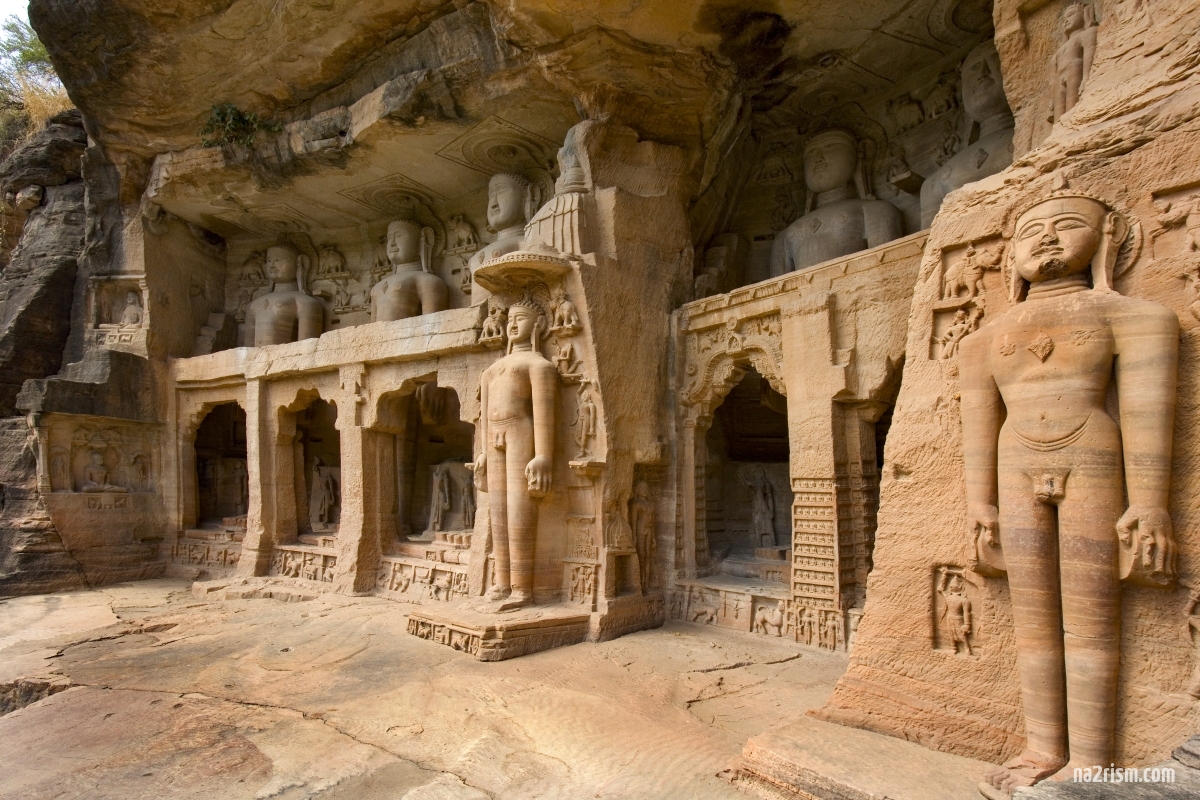Jainism, an ancient Indian religion known for its principles of non-violence, asceticism, and deep philosophical inquiry, has a unique and intricate relationship with nudity. As one of the oldest religious traditions, Jainism offers perspectives on nudity that are interwoven with its core tenets of non-attachment, purity, and renunciation. Nudity in Jainism is not merely a physical state but rather a profound symbol of spiritual purity, the rejection of materialism, and a path to liberation (moksha). This article delves into the complex attitudes toward nudity in Jainism, particularly as practiced by the sects that uphold it as an essential component of ascetic life, while also exploring how these attitudes align with or diverge from broader cultural and religious norms.
The Philosophical Foundation of Jainism
At the heart of Jainism lies a commitment to ahimsa (non-violence), aparigraha (non-attachment), and anekantavada (many-sidedness). These principles form the philosophical foundation upon which Jain attitudes toward the physical body, and by extension nudity, are built.
Ahimsa dictates a reverence for all living beings, leading Jains to avoid harm in every aspect of life. Aparigraha, or the renunciation of material possessions, extends beyond the mere rejection of wealth and comforts to include the shedding of clothing. This symbolizes a complete detachment from worldly desires, where clothing is seen as an unnecessary attachment that binds the soul to the material world. Finally, anekantavada — the belief that reality is complex and multifaceted — allows for differing perspectives on practices like nudity within the Jain community, leading to the emergence of two major sects with differing views: the Digambara (“sky-clad”) and Svetambara (“white-clad”) traditions.
Digambara: The “Sky-Clad” Ascetics
The Digambara sect is most closely associated with the practice of nudity in Jainism. The term “Digambara” itself translates to “sky-clad”, indicating that the sky is the only covering for the monks of this tradition. For Digambara monks, nudity is not merely a superficial act of renunciation but a profound declaration of their commitment to spiritual purity and asceticism.
Digambara monks believe that wearing clothes is a form of attachment, an obstacle in their journey toward liberation. By abandoning all material possessions, including clothing, they seek to sever ties with the physical world and focus entirely on spiritual advancement. Nudity in this context represents a radical rejection of ego and identity, aligning with the Jain principle that the body is ultimately a vessel for the soul, not a source of identity or worth. The unclothed body becomes a symbol of total freedom from desire, attachment, and the distractions of the physical world.
The practice of nudity, however, is reserved exclusively for male monks within the Digambara sect. Nuns and lay followers of both genders are not expected to adopt this practice, a reflection of the pragmatic considerations and the social realities in which Jainism has existed. Digambara monks live in isolated communities or forests, away from society, where they engage in meditation, fasting, and other forms of extreme asceticism. Their renunciation of clothing is seen as one of the ultimate tests of their spiritual discipline and commitment to the path of liberation.
Svetambara: The “White-Clad” Tradition
In contrast to the Digambaras, the Svetambara sect does not advocate for complete nudity. The term “Svetambara” means “white-clad”, reflecting the tradition’s practice of wearing simple white garments as a symbol of purity. Svetambara monks and nuns, while still adhering to strict ascetic principles, do not view clothing as an impediment to spiritual progress. For them, modesty and humility can be maintained through the wearing of minimal, plain clothing, which is devoid of any ornamentation or luxury.
Svetambara monks argue that the spiritual path does not necessarily require the complete rejection of clothing, but rather a detachment from the ego associated with it. They believe that one can still achieve liberation while maintaining a modest covering, as long as the focus remains on inner purity and the renunciation of desires. For the Svetambara sect, the act of wearing simple clothing is seen as a way to interact with society in a more practical and socially acceptable manner, while still adhering to the core Jain principles of non-attachment and humility.
The divergence between Digambara and Svetambara views on nudity highlights the flexibility within Jainism when it comes to ascetic practices. Both sects share the same goal of liberation from the cycle of birth and rebirth, but they differ in the methods they believe are necessary to achieve it. The role of nudity in Jainism, therefore, is not monolithic; it is shaped by differing interpretations of what it means to live a life free of attachments.
Symbolism of Nudity in Jainism
Nudity in Jainism is loaded with symbolic meaning, particularly in the Digambara tradition. It is viewed as a powerful statement of renunciation and spiritual discipline. The naked monk, stripped of all possessions and worldly attachments, becomes a living symbol of the Jain ideal: the pursuit of spiritual liberation free from the distractions and temptations of the material world.
The body, in Jain thought, is often seen as a source of suffering and limitation. Jain ascetics strive to transcend the needs and desires of the body, viewing it as a temporary vessel that ultimately binds the soul to the cycle of birth, death, and rebirth (samsara). By renouncing clothing, the Digambara monk makes a public declaration of his rejection of the body’s needs and his determination to overcome the limitations imposed by physical existence.
This symbolic act also serves as a reminder to lay Jains of the importance of detachment in their own lives. While lay practitioners may not be required to renounce clothing or other possessions to the same extent as monks, the example set by ascetics encourages them to cultivate non-attachment in their daily lives. For Jains, the practice of nudity serves as an aspirational symbol of spiritual purity and a reminder of the impermanence of the material world.
The Social and Cultural Context of Nudity in Jainism
While nudity holds deep spiritual significance within Jain asceticism, it has also historically been a point of contention within Indian society. Jainism, which has coexisted with Hinduism, Buddhism, and other religious traditions for millennia, has often found itself in dialogue or conflict with broader social norms regarding modesty and the role of asceticism.
The practice of nudity by Digambara monks, for instance, has sometimes been met with resistance or misunderstanding by non-Jains, particularly in more conservative or orthodox communities. In Hindu society, for example, nudity has generally been associated with divine figures or certain extreme ascetic practices, but it is not as widely accepted in everyday ascetic life. As a result, Digambara monks often live in seclusion, away from the gaze of mainstream society, to avoid misunderstandings or social conflict.
Despite these challenges, the Jain practice of nudity has persisted for over two millennia, a testament to the strength of Jain ascetic traditions. While Jainism represents a minority religion in India, its influence on Indian culture and religious thought is undeniable. The willingness of Jain ascetics to renounce even the most basic of human needs — clothing — demonstrates the extraordinary commitment to spiritual purity and the pursuit of liberation that lies at the heart of Jain philosophy.
Nudity and Modern Jain Practice
In contemporary Jainism, attitudes toward nudity are largely shaped by the sect to which one belongs and the level of one’s commitment to ascetic life. While Digambara monks continue to practice nudity in the traditional sense, lay Jains, and Svetambara adherents tend to embrace more moderate forms of renunciation. For the vast majority of Jains, nudity is not a requirement for spiritual progress, though it remains a powerful symbol of the ultimate renunciation of worldly attachments.
The role of nudity in Jainism today must also be understood in the context of modern societal norms and legal frameworks. In many parts of the world, including India, public nudity is restricted by law, and this has had an impact on how Jain ascetics practice their faith. While Digambara monks still maintain the tradition of nudity in private or secluded environments, they may wear minimal coverings when interacting with the public to avoid legal complications.
In this way, modern Jainism continues to balance the ancient principles of asceticism with the practical realities of living in a more interconnected and legally structured world. For Jains, the essence of asceticism — whether expressed through nudity or other forms of renunciation — remains the same: the ultimate goal is to cultivate detachment from the material world and to strive for spiritual liberation.
Unveiling the Spiritual Core
Nudity in Jainism is deeply symbolic, representing the ultimate renunciation of worldly attachments and the pursuit of spiritual purity. While the practice is most closely associated with the Digambara sect, which views nudity as essential to the path of liberation, other sects like the Svetambaras embrace more moderate forms of asceticism. The divergent attitudes toward nudity within Jainism reflect the religion’s broader emphasis on non-attachment, humility, and spiritual discipline.
In both historical and modern contexts, the role of nudity in Jainism illustrates the profound commitment of Jain ascetics to transcending the limitations of the body and achieving liberation from the cycle of samsara. Whether practiced in its most extreme form or embraced symbolically, nudity in Jainism remains a powerful expression of the religion’s core values and its distinctive approach to the physical and spiritual dimensions of existence.

